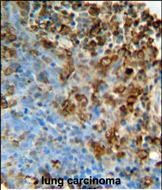ITPA Antibody (N-term)
Affinity Purified Rabbit Polyclonal Antibody (Pab)
- SPECIFICATION
- CITATIONS
- PROTOCOLS
- BACKGROUND

Application
| WB, IF, FC, IHC-P, E |
|---|---|
| Primary Accession | Q9BY32 |
| Other Accession | Q2NLA8, D3ZW55, Q9D892, F1NLH9, Q2KIC5 |
| Reactivity | Human |
| Predicted | Bovine, Chicken, Mouse, Rat, Xenopus |
| Host | Rabbit |
| Clonality | Polyclonal |
| Isotype | Rabbit IgG |
| Calculated MW | 21446 Da |
| Antigen Region | 24-51 aa |
| Gene ID | 3704 |
|---|---|
| Other Names | Inosine triphosphate pyrophosphatase {ECO:0000255|HAMAP-Rule:MF_03148}, ITPase {ECO:0000255|HAMAP-Rule:MF_03148}, Inosine triphosphatase {ECO:0000255|HAMAP-Rule:MF_03148}, 36119 {ECO:0000255|HAMAP-Rule:MF_03148}, Non-canonical purine NTP pyrophosphatase {ECO:0000255|HAMAP-Rule:MF_03148}, Non-standard purine NTP pyrophosphatase {ECO:0000255|HAMAP-Rule:MF_03148}, Nucleoside-triphosphate diphosphatase {ECO:0000255|HAMAP-Rule:MF_03148}, Nucleoside-triphosphate pyrophosphatase {ECO:0000255|HAMAP-Rule:MF_03148}, NTPase {ECO:0000255|HAMAP-Rule:MF_03148}, Putative oncogene protein hlc14-06-p, ITPA {ECO:0000255|HAMAP-Rule:MF_03148}, C20orf37 |
| Target/Specificity | This ITPA antibody is generated from rabbits immunized with a KLH conjugated synthetic peptide between 24-51 amino acids from the N-terminal region of human ITPA. |
| Dilution | IF~~1:25 WB~~1:1000 IHC-P~~1:50~100 FC~~1:10~50 |
| Format | Purified polyclonal antibody supplied in PBS with 0.09% (W/V) sodium azide. This antibody is purified through a protein A column, followed by peptide affinity purification. |
| Storage | Maintain refrigerated at 2-8°C for up to 2 weeks. For long term storage store at -20°C in small aliquots to prevent freeze-thaw cycles. |
| Precautions | ITPA Antibody (N-term) is for research use only and not for use in diagnostic or therapeutic procedures. |
| Name | ITPA {ECO:0000255|HAMAP-Rule:MF_03148} |
|---|---|
| Synonyms | C20orf37 |
| Function | Pyrophosphatase that hydrolyzes the non-canonical purine nucleotides inosine triphosphate (ITP), deoxyinosine triphosphate (dITP) as well as 2'-deoxy-N-6-hydroxylaminopurine triphosphate (dHAPTP) and xanthosine 5'-triphosphate (XTP) to their respective monophosphate derivatives. The enzyme does not distinguish between the deoxy- and ribose forms. Probably excludes non-canonical purines from RNA and DNA precursor pools, thus preventing their incorporation into RNA and DNA and avoiding chromosomal lesions. |
| Cellular Location | Cytoplasm {ECO:0000255|HAMAP-Rule:MF_03148, ECO:0000269|PubMed:11278832} |
| Tissue Location | Ubiquitous. Highly expressed in heart, liver, sex glands, thyroid and adrenal gland |

Thousands of laboratories across the world have published research that depended on the performance of antibodies from Abcepta to advance their research. Check out links to articles that cite our products in major peer-reviewed journals, organized by research category.
info@abcepta.com, and receive a free "I Love Antibodies" mug.
Provided below are standard protocols that you may find useful for product applications.
Background
ITPA hydrolyzes inosine triphosphate and deoxyinosine triphosphate to the monophosphate nucleotide and diphosphate. The encoded protein, which is a member of the HAM1 NTPase protein family, is found in the cytoplasm and acts as a homodimer. Defects in the encoded protein can result in inosine triphosphate pyrophosphorylase deficiency. Two transcript variants encoding two different isoforms have been found for this gene.
References
Fellay, J., et al. Nature 464(7287):405-408(2010)
Herting, G., et al. Biochim. Biophys. Acta 1802(2):269-274(2010)
Kudo, M., et al. Drug Metab. Pharmacokinet. 24(6):557-564(2009)
If you have used an Abcepta product and would like to share how it has performed, please click on the "Submit Review" button and provide the requested information. Our staff will examine and post your review and contact you if needed.
If you have any additional inquiries please email technical services at tech@abcepta.com.













 Foundational characteristics of cancer include proliferation, angiogenesis, migration, evasion of apoptosis, and cellular immortality. Find key markers for these cellular processes and antibodies to detect them.
Foundational characteristics of cancer include proliferation, angiogenesis, migration, evasion of apoptosis, and cellular immortality. Find key markers for these cellular processes and antibodies to detect them. The SUMOplot™ Analysis Program predicts and scores sumoylation sites in your protein. SUMOylation is a post-translational modification involved in various cellular processes, such as nuclear-cytosolic transport, transcriptional regulation, apoptosis, protein stability, response to stress, and progression through the cell cycle.
The SUMOplot™ Analysis Program predicts and scores sumoylation sites in your protein. SUMOylation is a post-translational modification involved in various cellular processes, such as nuclear-cytosolic transport, transcriptional regulation, apoptosis, protein stability, response to stress, and progression through the cell cycle. The Autophagy Receptor Motif Plotter predicts and scores autophagy receptor binding sites in your protein. Identifying proteins connected to this pathway is critical to understanding the role of autophagy in physiological as well as pathological processes such as development, differentiation, neurodegenerative diseases, stress, infection, and cancer.
The Autophagy Receptor Motif Plotter predicts and scores autophagy receptor binding sites in your protein. Identifying proteins connected to this pathway is critical to understanding the role of autophagy in physiological as well as pathological processes such as development, differentiation, neurodegenerative diseases, stress, infection, and cancer.





